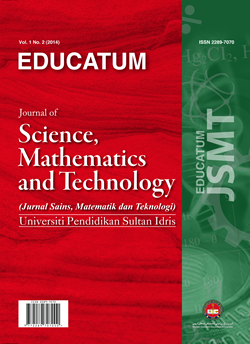Exploring the magnetic field strength of a solenoid using the magnetometer of a smartphone
DOI:
https://doi.org/10.37134/ejsmt.vol11.1.1.2024Keywords:
magnetic field strength, solenoid, magnetometer, smartphone learning, physics teachingAbstract
This paper investigated the magnetic field strength of a solenoid using the magnetometer of a smartphone. There were three experiments: magnetic field strength versus current; magnetic field strength versus number of turns; and magnetic field strength vs distance between smartphone and solenoid. The result of the experiment has found that magnetic field strength and current and magnetic field strength and number of turns have direct relationship to one another and conformed with the Ampere’s Law. Meanwhile, the magnetic field strength vs distance between smartphone and solenoid has an exponential relationship. This paper recommended to verify the permittivity of free space by revising the experimental set-up. From educational uses to practical applications, it provides the teaching and learning process with a convenient tool for measuring magnetic field strength at various points with incredible precision and accuracy with minimal effort required.
Downloads
References
Wannous, J., & Horváth, P. (2021, February). Measuring the Permeability of Vacuum Using a Smartphone. In Proceedings INNODOCT/20. International Conference on Innovation, Documentation and Education (pp. 63-70). Editorial Universitat Politècnica de València.
Teeka, C. (2019). Magnetic field strength measurement by using smartphone magnetometer sensors. Retrieved from https://www.researchgate.net/publication/334635008_Magnetic_Field_Strength_Measurement_By_Using_Smartphone_Magnetometer_Sensors
Badr, M. F. (2018, November). Modelling and simulation of a controlled solenoid. In IOP Conference Series: Materials Science and Engineering (Vol. 433, No. 1, p. 012082). IOP Publishing.
Abuhamad, M., Abuhmed, T., Mohaisen, D., & Nyang, D. (2020). AUToSen: Deep learning-based implicit continuous authentication using smartphone sensors. IEEE Internet of Things Journal, 7(6), 5008-5020.
Wattanayotin, P., Puttharugsa, C., & Khemmani, S. (2017). Investigation of the rolling motion of a hollow cylinder using a smartphone’s digital compass. Physics Education, 52(4), 045009.
National Aeronautics and Space Administration (2023). Exploring magnetism with smart devices: A NASA educator’s guide for grades 3-12. Retrieved from https://spacemath.gsfc.nasa.gov/SMBooks/MagnetismGuide.pdf
Samavati, A., Samavati, Z., Ismail, A. F., Yahya, N., Bakar, M. A. A., Othman, M. H. D., ...& Osman, S. S. (2020). Magnetic field detection using a highly sensitive FBG probe. Physica Scripta, 95(3), 035509.
Kaps, A., & Stallmach, F. (2022). Investigation of the flux density of a solenoid using the magnetometer of smartphones. The Physics Teacher, 60(1), 70-71.
Kuhlmann, T., Garaizar, P., & Reips, U. D. (2021). Smartphone sensor accuracy varies from device to device in mobile research: The case of spatial orientation. Behavior research methods, 53, 22-33.
Ripka, P., Mirzaei, M., & Blažek, J. (2021). Magnetic position sensors. Measurement Science and Technology, 33(2), 022002.
Oprea, M., & Miron, C. (2014). Mobile phones in the modern teaching of physics. Romanian reports in Physics, 66(4), 1236-1252.
Giancoli, D. C. (2014). Physics for scientists & engineers with modern physics (Vol. 762). San Francisco: Pearson.
Hellesund, S. (2018). Measuring Earth's Magnetic Field Using a Smartphone Magnetometer. arXiv preprint arXiv:1901.00857.
Downloads
Published
Issue
Section
License
Copyright (c) 2024 Frank Angelo Pacala, Unofre Pili

This work is licensed under a Creative Commons Attribution-NonCommercial-ShareAlike 4.0 International License.





